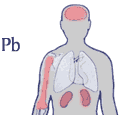
Nitrogen Dioxide

Ozone

Carbon Monoxide

Sulfur Dioxide

Particulate Matter

Lead
|
 
Lead - Pb
Lead is a metallic element that occurs naturally in soil, rocks, water, and food. Until the mid-1970's we used huge, concentrated amounts of lead in gasoline for our cars and in paint for our houses. The biggest success story for cleaner air came when we changed to unleaded gas and paint, reducing the lead in the air by 90%. However, we still use lead in some products.
Source
Even though lead in the air from car exhaust has been dramatically reduced, leaded gas is still used for small planes and race cars. Lead is also used in lead-acid car batteries. Although it is no longer allowed in U.S. house paints, it is still used in industrial coatings. Right now, at least 70% of lead pollution comes from smelters, power plants fueled by coal, and lead used in the processing of oil shale.
How It Hurts
Lead enters our bodies in contaminated soil, water, dust, paint, and food. We can also just directly breathe it in. Lead particles small enough to be inhaled into the lungs are easily absorbed into the blood and circulated throughout the body. Their most important target is the brain. Even low levels of lead exposure can increase blood pressure and permanently lower children's IQ. Higher levels can make any of us anemic -- damaging our red blood cells and sapping our energy.

Back to Criteria Pollutants Top Level
|

Lead attacks the brain, the blood and the kidneys

|
